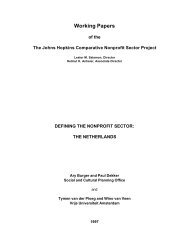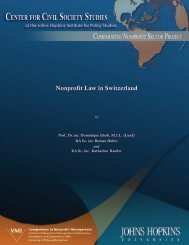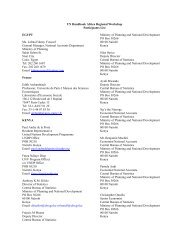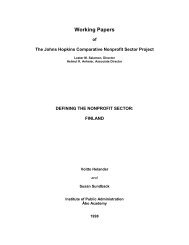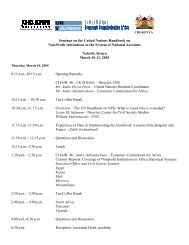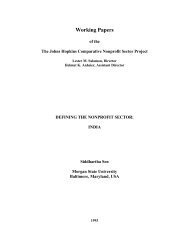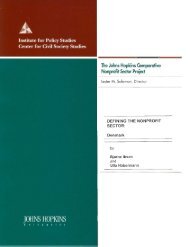Campetella, González Bombal, and Roitter<strong>Defining</strong> <strong>the</strong> <strong>Nonprofit</strong> <strong>Sector</strong>: <strong>Argentina</strong>regulations and promotion, because <strong>the</strong>y considered that those were <strong>the</strong> first steps towards reaching<strong>the</strong> final objective of a national social security system.On <strong>the</strong> o<strong>the</strong>r hand, <strong>the</strong> widening of <strong>the</strong> political system also led to fluid relationships betweenpolitical parties and civil society, which were mainly institutionalized through neighborhoodorganizations, called comités de base (base committees). These comités were created by <strong>the</strong> RadicalParty and were usually controlled by a neighborhood caudillo (political broker) that offered a greatvariety of services –from giving food and housing to <strong>the</strong> provision of medical services– to attractsupporters. 7 The Socialist Party created its own centers, which had mainly a cultural and educationalprofile. In <strong>the</strong>se centers, where neighbors could find libraries and attend different types of courses,socialist leaders promoted cooperativism and fought against what <strong>the</strong>y considered <strong>the</strong> main socialproblems of those times, i.e., alcoholism, gambling and prostitution.This period was also marked by significant urban development –mainly in <strong>the</strong> FederalDistrict and <strong>the</strong> suburbs– caused not by foreign immigration, which had already reached it greatestmomentum towards <strong>the</strong> end of <strong>the</strong> 19 th century, but by internal migration from rural areas to <strong>the</strong>cities. This urban development was accompanied by <strong>the</strong> mushrooming of neighborhoodassociations, often created to deal with <strong>the</strong> necessities of new and suburban neighborhoods, that is,utilities –electric power, gas, water, etc.–, and social, educational, and recreational spaces.After <strong>the</strong> 1930 coup d’etat a restricted and fraudulent political system was established, knownas <strong>the</strong> década infame (<strong>the</strong> “infamous decade”). From <strong>the</strong> point of view of nonprofit institutions, thisdécada infame was concurrent with <strong>the</strong> fur<strong>the</strong>r development of neighborhood associations, <strong>the</strong>organization of mutual benefit associations into networks aiming to achieve a national social securitysystem, and <strong>the</strong> continued existence of <strong>the</strong> charities linked to <strong>the</strong> Catholic Church and high societyladies. The state for its part gradually started to expand its interventionist and regulatory activitiesnot only in <strong>the</strong> social assistance fields, but also in industry, which had experienced tremendousdevelopment in those years.Populism and Social RightsIn 1946 Juan Domingo Perón was elected president in fair elections, and governed until 1955,when he was overthrown by ano<strong>the</strong>r coup d’etat. During that decade, under peronism, <strong>Argentina</strong>went through great social, economic and institutional transformations that included <strong>the</strong> enactment ofa new Constitution in 1949. The central mechanism for <strong>the</strong>se transformations was <strong>the</strong> extension ofsocial rights –e.g., health, educational, social welfare– by means of <strong>the</strong> generalization of socialsecurity for <strong>the</strong> working class, in <strong>the</strong> context of an economic model that promoted industrialdevelopment. The central actors of <strong>the</strong>se transformations were <strong>the</strong> state in conjunction with tradeunions and small and medium-scale industrial enterprises. Social scientists have conceptualized thismodel of relationship between state and society, common to several Latin American countries since<strong>the</strong> early 1940s, as populism.7This practice of political clientelism, which had precedent in <strong>the</strong> conservative parties of <strong>the</strong> previous period, openeda main chapter of Argentine politics, directly involving civil society and its organizations. See Auyero, 1996.5
Campetella, González Bombal, and Roitter<strong>Defining</strong> <strong>the</strong> <strong>Nonprofit</strong> <strong>Sector</strong>: <strong>Argentina</strong>In this period <strong>the</strong> mentioned blurring between <strong>the</strong> borders of <strong>the</strong> spheres of state, market andcivil society experienced an essential modification, as <strong>the</strong> significant regulatory and interventionistrole of <strong>the</strong> state developed. Regarding third sector institutions, a great number of <strong>the</strong>m wereregulated by <strong>the</strong> state in accordance with <strong>the</strong> idea of integrating <strong>the</strong>m into national systems.• Small trade unions organized within <strong>the</strong> different industrial corporations were replaced bylarge trade unions that ga<strong>the</strong>red all workers of <strong>the</strong> same activity branch –e.g., railroademployees, metal workers, etc. In turn, <strong>the</strong>se large trade unions joined into a singleconfederation, <strong>the</strong> Confederación General del Trabajo or CGT (General LaborConfederation). 8• Mutual benefit associations related to trade unions constituted <strong>the</strong> origin of <strong>the</strong> obrassociales (workers’ medical insurance organizations), institutions that were <strong>the</strong> basis for <strong>the</strong>national health system articulated by <strong>the</strong> state. This system provided egalitarian and integralhealth services for all workers.• The Sociedad de Beneficencia was dissolved, and for <strong>the</strong> first time <strong>the</strong> traditional linkbetween <strong>the</strong> state and upper class philanthropy was severed. At <strong>the</strong> same time, <strong>the</strong>Fundación Eva Perón (Eva Perón Foundation), was established to provide social services to<strong>the</strong> population excluded from <strong>the</strong> labor market and, consequently, from <strong>the</strong> national securityand health systems. This Foundation maintained <strong>the</strong> same ambiguous place between <strong>the</strong>public and <strong>the</strong> private realms inaugurated by <strong>the</strong> Sociedad de Beneficencia. It was legallydefined as a “private institution fulfilling public functions and concerned with nationalproblems,” and in a couple of years its activity was greater than that of <strong>the</strong> public office incharge of social assistance. Fur<strong>the</strong>rmore, <strong>the</strong> Fundación Eva Perón became a symbol of <strong>the</strong>Peronist state.Peronism also reformulated <strong>the</strong> relationship between political parties and civil societyinitiated by comités radicales and socialist centers. At <strong>the</strong> grassroots level, peronism was structuredinto an institutional network composed of unidades básicas (basic units), neighborhoodorganizations established in all cities and towns throughout <strong>the</strong> country. These organizationsfunctioned as <strong>the</strong> social base of <strong>the</strong> Peronist movement, and at <strong>the</strong> same time, as <strong>the</strong> places whereneighbors could participate actively in public affairs. Even though <strong>the</strong> comités radicales andsocialist centers remained, <strong>the</strong> unidades básicas played a more prominent role owing to <strong>the</strong>irprivileged relationship with governmental institutions and <strong>the</strong> consequent advantages <strong>the</strong>y had at <strong>the</strong>time of meeting <strong>the</strong> needs of <strong>the</strong> neighborhoods. On <strong>the</strong> o<strong>the</strong>r hand, given <strong>the</strong> fact that peronism wasa political movement and not only a political party, <strong>the</strong> unidades básicas operated beyond <strong>the</strong> partysystem, incarnating a direct linkage between political identity and civil society.8Trade union legislation recognized only one general labor confederation. However, after Perón was overthrown in1955, political confrontations led to <strong>the</strong> existence of two confederations.6
- Page 1 and 2: Working PapersofThe Johns Hopkins C
- Page 3 and 4: PREFACEThis is one in a series of W
- Page 5 and 6: Campetella, González Bombal, and R
- Page 7: Campetella, González Bombal, and R
- Page 11 and 12: Campetella, González Bombal, and R
- Page 13 and 14: Campetella, González Bombal, and R
- Page 15 and 16: Campetella, González Bombal, and R
- Page 17 and 18: Campetella, González Bombal, and R
- Page 19 and 20: Campetella, González Bombal, and R
- Page 21 and 22: Campetella, González Bombal, and R
- Page 23 and 24: Campetella, González Bombal, and R
- Page 25 and 26: Campetella, González Bombal, and R
- Page 27 and 28: Campetella, González Bombal, and R
- Page 29 and 30: Campetella, González Bombal, and R
- Page 31 and 32: Campetella, González Bombal, and R
- Page 33: Campetella, González Bombal, and R



